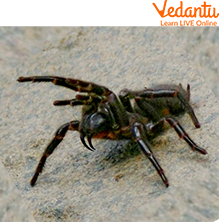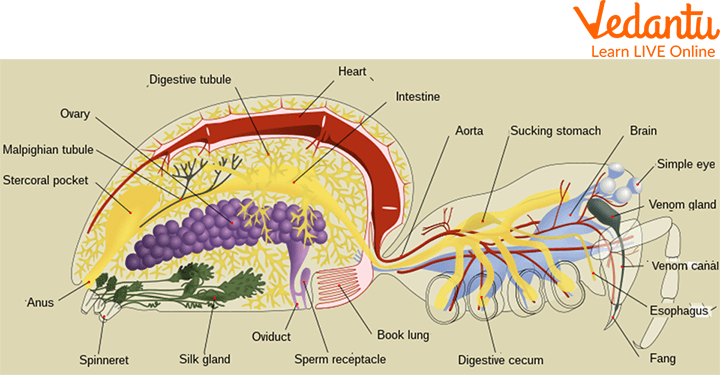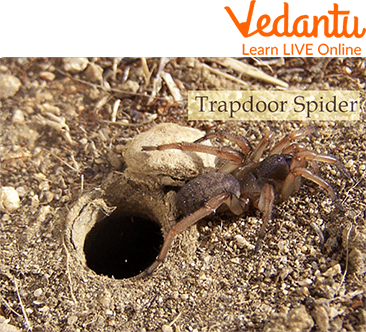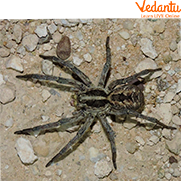




How the Spiders Really Are?
Spiders are 8-legged creatures known for making silk webs to catch insects. Antarctica is the only place where there are no spiders. There are about 40,000 species of spiders. They are, however, related to scorpions, ticks, and mites. In this spider article for kids, we will learn about spiders.
Spiders are predators and prey on insects. They have several ways to catch their prey like building spider webs and using a thread of silk which they throw at their prey. Some kinds of spiders hide inside holes in the ground, then run out and grab their prey that walks by. Others will throw web nets at passing insects. This article contains spider facts for kids, it can be considered spider research for kids.

The Sydney Funnel Web Spide
Spider Anatomy
Anatomy basically means the identification and description of living beings. Given below is the spider anatomy for kids.
Physical Features of Spiders
Spiders are about 0.02 to 3.5 inches long. The largest spiders are tarantulas. A spider has two major body parts: the cephalothorax and the abdomen. Let’s have a look at the parts of a spider for kids:
Cephalothorax: The cephalothorax contains the stomach and brain and the legs are attached to this part
Abdomen: The abdomen contains the gut, the heart, the reproductive parts, and the silk-making parts.
Spiders have four pairs of legs that have claws at the tip. Few of the species use the first pair of legs to feel and to find their prey.
Near the rear of their body, spiders have silk-making organs called spinnerets. They produce a liquid made from special glands which further becomes a solid thread after it is released from their body.
Many spiders make venom, or poison, that they shoot at their prey. The venom of most spiders is not harmful to people. But spiders like the black widow and the brown recluse, can cause damage and sometimes death in humans.
The silk created from spinneret glands in their abdomen is extremely strong, and can be used for different things. Spiders use their silk to create webs, to catch their prey although there are a few different kinds of spider webs, like orbs, funnels and sheets but not all spiders catch their prey in webs – some hide and wait for insects to come by.

Anatomy of a Spider
Types of Spiders
Spiders feed mostly on insects. Let’s see some types of spiders for kids:
Some spiders are good hunters that chase their prey. These spiders have a good sense of touch or sight.
Some spiders weave silk webs where they trap flying insects.
Some spiders rely on their silk to wrap their prey, make nests or protect their eggs.
Spiders are the only creatures that digest their food outside their bodies. After capturing its prey, a spider covers it with digestive juices that break down the prey’s body into a liquid form that the spider sucks up. Spiders repeat this process and eventually digest most of the prey.

Trapdoor Spider

Carolina Wolf spider
Life Cycle of Spiders
Female spiders lay egg sacs that hold thousands of eggs. The youngest of most species go off on their own after coming out of the egg sac. Spiders' appearance doesn’t change much as they grow. They shed their outer covering, multiple times before becoming adults.
Interesting Facts About Spider
These interesting facts contain a lot of spider information for kids.
In the UK, there have been no deaths recorded from a spider bite.
For a spider, it takes about an hour to build a web, and they usually build a new one every day.
Spiders don’t always use the web to catch food. For instance, the wolf spider makes a hole in the ground and waits there for the prey to come near before catching them.
The largest spiders are tarantulas, and the largest tarantula is the Goliath tarantula.
The smallest spider is the Patu marplesi, and it was found in Samoa (in the South Pacific Ocean).
Even though spiders have eight eyes, they can’t see very well – they rely on their sensations in order to know if they’ve caught prey in the webs.
Summary
Spiders are arthropods, like insects – they have an exoskeleton that is on the outside of their body instead of the inside (unlike humans). There are around 40,000 known species of spiders. There are a few main differences between spiders and insects, and one of these is the number of legs – all spiders have eight legs and their bodies have two major parts – the cephalothorax and the abdomen.
This spider article for kids has a lot of information about the anatomy of spiders, the types of spiders, and the life cycle of spiders. We got to know about parts of a spider for kids through this article.
FAQs on Spider Facts for Kids
1. Which animal family do spiders belong to?
Spiders belong to a group of animals called “arachnids''. Mites, scorpions, and ticks are also part of the family. Creatures with two body segments, eight legs, no wings or antennae and inability to chew come under the arachnids family.
2. Why do spiders have 8 legs?
8-legged spiders and 2-legged people survived and reproduced. Spiders have 8 legs, as their ancestors had 8 legs. Horseshoe crabs and spiders evolved from the same ancestors.
3. Do spiders have teeth?
In its most common use, spiders bite their prey and inject venom, which immobilises the prey and starts the process of digestion. Spiders don’t have teeth but they rely on their venom to liquefy their prey so that their stomach can draw in the meal.









